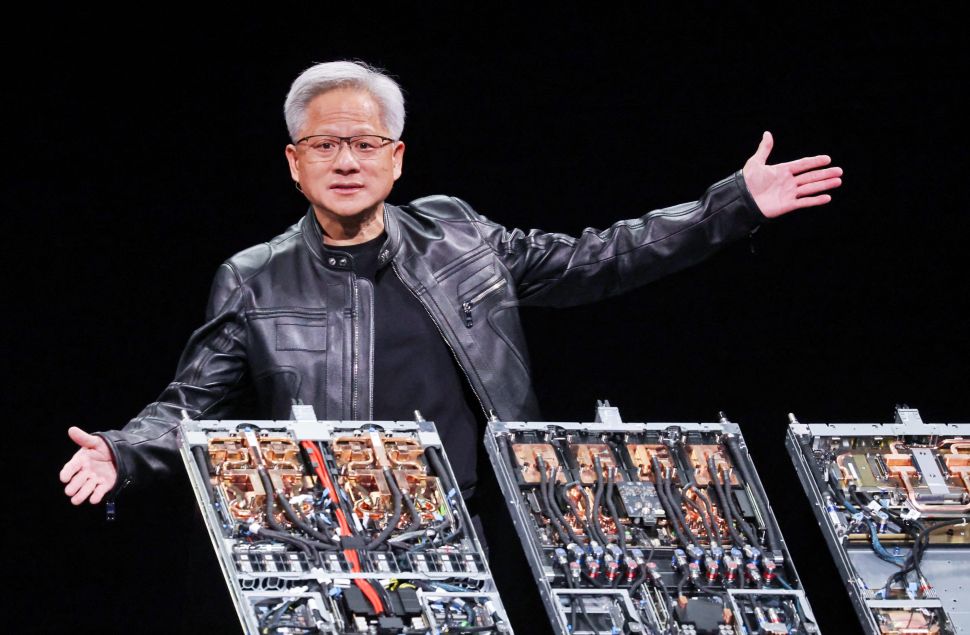Nvidia co-founder and CEO Jensen Huang delivers the first keynote speech of Computex 2025 at the Taipei Music Center in Taipei on May 19, 2025.” width=”970″ height=”636″ data-caption=’Jensen Huang delivers the first keynote speech of Computex 2025 at the Taipei Music Center in Taipei on May 19, 2025. <span class=”lazyload media-credit”>I-HWA CHENG/AFP via Getty Images</span>’>
At Computex 2025, Nvidia CEO Jensen Huang returned to his birthplace of Taipei, Taiwan to deliver a sweeping keynote that outlined the company’s audacious next chapter. Before a crowd of more than 4,000 at the Taipei Music Center, Huang positioned Nvidia as more than a GPU powerhouse—now a full-stack A.I. infrastructure provider spanning silicon, systems and software.
His keynote touched on everything from next-gen chip architecture to robotics and supercomputing, signaling Nvidia’s central role in shaping the future of A.I. across industries and borders.
Here are five top takeaways from his keynote:
From data centers to “A.I. factories”
Huang called for a conceptual shift in how we describe the infrastructure powering the A.I. era. “Data center” is no longer an adequate term, he argued—instead, these facilities should be viewed as “A.I. factories,” where intelligence is manufactured like any other industrial output.
“You apply energy to it, and it produces something incredibly valuable,” Huang said. “These things are called tokens.” Comparing these facilities to past revolutions built on roads and electrical grids, he emphasized that accelerated computing is now essential national infrastructure. “A.I. factories are the next great industry—and they’re worth trillions.”
Reshaping A.I. system design with NVLink Fusion
A major technical announcement was the debut of NVLink Fusion, an updated interconnect architecture that expands Nvidia’s chip ecosystem. The platform will allow third-party CPUs and A.I. accelerators to link directly to Nvidia GPUs, opening the door to semi-custom A.I. systems designed with partners like Qualcomm, Marvell, MediaTek and Fujitsu.
A Supercomputer for Taiwan
Huang announced the creation of Taiwan’s first A.I. supercomputer, a partnership between Nvidia, Apple supplier Foxconn and the Taiwanese government.
Designed to strengthen Taiwan’s role as a global A.I. hub, the facility will be powered by 10,000 Blackwell GPUs and support the region’s A.I. ecosystem, including TSMC, startups, and academic researchers. The buildout will begin with a 20-megawatt deployment and scale to 100 megawatts across multiple sites, starting in Kaohsiung.
Huang noted that Nvidia now has 350 partners in Taiwan. “Having a world-class A.I. infrastructure here in Taiwan is really important,” he said. “But Taiwan isn’t just building A.I. for the world; Nvidia is helping build A.I. for Taiwan.”
Physical A.I. systems to mitigate labor shortages
Perhaps the most forward-looking segment of Huang’s keynote focused on robotics and agentic A.I.
Nvidia unveiled Isaac GR00T N1.5, a foundation model and development platform that serves as the “A.I. brain” for humanoid robots, enabling them to reason, adapt and execute complex tasks.
Paired with GR00T-Dreams, a new simulation environment for training robots in virtual settings, the tools aim to address one of robotics’ key challenges: acquiring high-quality motion data. Huang projected that these advances will bring A.I.-powered physical labor to sectors like logistics, healthcare, and manufacturing. “Physical A.I. and robotics will bring about the next industrial revolution,” he said.
DGX Spark: a desktop supercomputer
In a final reveal, Nvidia introduced DGX Spark—a compact, high-performance A.I. supercomputer designed for desktops. Built on the GB200 Grace Blackwell Superchip, DGX Spark delivers 1,000 TOPS (trillion operations per second) and aims to democratize A.I. development.
By offering this scale of computing power outside of massive data centers, Nvidia hopes to empower smaller labs, researchers, and even individuals to innovate in A.I. without needing enterprise-scale infrastructure.

